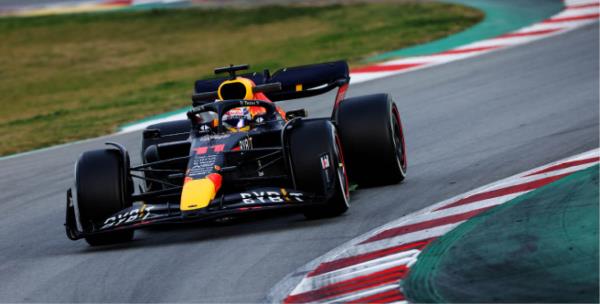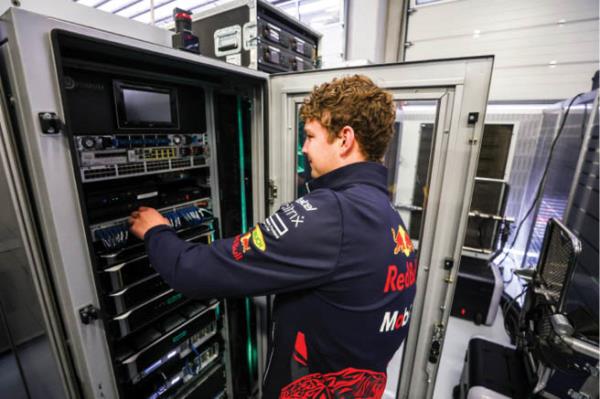04 November 2022

The Formula One™ season lasts eight or nine months, however, design teams are hard at work year-round to improve performance. Designing racing cars is a continuous process of integrating technology-driven innovations, making Formula One™ more than just a race; it is also a competition of technology. Behind the scenes, thousands of data points and dozens of applications come together to enhance race day results. Here, we explore how two racing teams upgraded their data storage and analysis in the search for gold
Oracle Red Bull Racing appoints HPE in race to the future
Oracle Red Bull Racing has sped its way to many victories across the world, with recent wins including the 2021 and 2022 Formula One™ World Driver’s Champion: Max Verstappen, as well as the CONSTRUCTORS’ WORLD CHAMPIONSHIP 2022.
The entire team is keen to push the car to the limit at each race. Insight-driven decisions, led by engineers, powered by IT and fuelled by data, can be the difference between winning and losing.
“We’re a data-driven business and that data is our lifeblood in terms of how we develop and optimise these cars,” said Oracle Red Bull Racing CEO and Team Principal, Christian Horner. “You only see our shop window at each Grand Prix, but you don’t see what goes on behind the scenes with the technology that we’re using and the boundaries that we’re pushing.”
In between races, the car is redesigned and rebuilt with customised specifications ready for the next track. Throughout a single season, a car can undergo 30,000 changes, involving 1,000 design elements per week. Every change in the process needs to be simulated, manufactured, and tested.
“For me, the perfect lap doesn’t exist. When we start looking into the data, there are always things you can improve,” said Verstappen.
Regulation changes
For the 2022 Formula One™ season, engineers were tasked to create under a new set of design regulations while staying within established cost caps. This made efficiency more important than ever.
“New regulations mean that whilst the team continues to innovate and push boundaries, we need to be very smart when it comes to the efficient use of resources, including how we get the most out of the IT estate that underpins car design and development processes,” said Matt Cadieux, Oracle Red Bull Racing CIO.
Further changes in Formula One™ rules include limiting how many aerodynamics testing hours each team can run per week, using a sliding scale based on last season’s performance. Red Bull Racing will have less time in the wind tunnel and computational fluid dynamics (CFD) simulation software than most teams due to its leading performances in previous years.
A software-designed platform
To meet these new regulations, Oracle Red Bull Racing partnered with Hewlett Packard Enterprise (HPE), which delivered a software-defined, composable platform based on HPE SimpliVity and HPE Synergy.
“Hewlett Packard Enterprise has partnered with Red Bull Racing for seven years, delivering cutting technology solutions to both the factory in Milton Keynes and to every racetrack around the globe with our trackside solutions,” said Adrian Lovell, CTO - financial services industry, HPE. “At the heart of this partnership is the data. In racing, where teams deal with extremely complex and constantly changing variables, including regulations, environmental conditions, and the tracks themselves, data can make the difference between winning or losing.”
Today, some 80% of day-to-day business applications are running on HPE SimpliVity.
“The car changes every race, our software changes every race, and as a result our infrastructure has to change every race,” said Chris Middleton, Head of IT Infrastructure Operations at Oracle Red Bull Racing. “We can bring new apps into play. We can bring new VMs, storage, networking. All of that can be added or removed, saving massive amounts of time.”
To support the complex CFD process, which underpins the aerodynamic development of the car throughout the season, virtualised Citrix Workspace runs on HPE SimpliVity. Data cross-analysis can thus be completed on a single workstation, enabling engineers to produce more design iterations, faster. HPE Synergy combined with HPE OneView allows the quick reallocation of compute or storage resources as required, enabling the team to meet changing needs and maximise IT usage. The platforms’ high density also enables cost savings via reduced power, cooling and footprint expenses. Moreover, HPE Primera is utilised for tier one storage, and helps guarantee 100% availability.
The first step in optimising aerodynamics is CFD simulations, testing how different design elements enhance speed. This involves compute-intensive workloads such as physics simulations and 3D imaging.
“CFD models underpin the speed of design development at Red Bull Racing. CFD produces complex 3D, graphically intense models and therefore the team needs significant and efficient compute power to derive the best outcomes,” said Cadieux. “These workloads run on HPE Apollo 2000, a high-performance computing cluster that provides the scale, speed, and efficiency the team requires to maximize CFD in a cost-effective manner.”
Data from CFD simulations is confirmed at the team’s wind tunnel in Bedford, where HPE Synergy provides compute for mixed workloads. 60% scale models are built and tested to choose the best design before manufacturing. Every second is optimised to gain valuable data, captured by a high-speed imaging system. These images, and all the data produced at the wind tunnel facility, are stored on HPE Nimble Storage, which delivers sub 0.5 milliseconds I/O latency for read and write operations.
Meanwhile, the use of HPE InfoSight, which delivers AI-enabled predictive analytics, enables the IT team to spend less time managing disk resources, and allows to deep dive into storage metrics. This delivers a greater understanding of workloads and the most efficient use of resources.
“Naturally, the requirements for IT systems in racing, and especially at the trackside are high: They need to operate at peak performance levels and with very high availability, while being lighter and more compact than traditional solutions, and robust at the same time. Moreover, they need to be capable of coping with the power cuts that are frequent at racetracks, to ensure continuous data processing,” said Lovell. “With HPE SimpliVity at the core of Red Bull Racing trackside data centre, which resides in the hospitable environment of the garage at each race, the team is able to capture and analyse race data in real time. In a race, where every second counts, this data is critical to instantly optimize car set-up and support key decisions.”
Data meets real world
“That race weekend, when we hit the circuit, that is our first chance to see at full scale how those components are going to perform. Is it going to be reflective of what we saw in our theory? That’s where the data comes face-to-face with the real world,” said Zoe Chilton, head of strategic partnerships.
HPE SimpliVity acts as the core of the team’s mobile data centre, providing post-processing of race telemetry data, as well as real-time insight to optimise car setup and support in-race decision-making. Its compact, robust, and seamless set up attributes make it ideal for trackside deployment.
“The data, thanks to the collaboration with our joint partner Citrix, can be accessed by engineers around the world through VDI environments provided by HPE,” said Lovell. “This setup allows the engineering team to directly analyse live data wherever that data resides with no delay. While the environment of a Formula One™ track is unique, many of the challenges faced are familiar to a large number of businesses. Real time simulation and data analysis are core to the success of more and more organizations. For both, HPE and Red Bull Racing, the insights won throughout these past seven years have been central to our work and the lessons HPE learns with every new race we then apply to the services and solutions we deliver off the racetrack.”

“Bringing HPE SimpliVity to support our trackside operations enables our trackside engineers to focus on car performance, knowing that they can rely on the IT infrastructure to deliver and back up the data that they need,” said Simon Kesslar-Lyne, head of Event IT at Red Bull Racing.
The amount of time taken to transfer hundreds of Gbs of data from the car in real time on race days for post-process analysis has reduced by 78%, from nine to two minutes.
“It’s a massive increase in performance,” said Cadieux. “What that means is we can get better answers quicker when we’re on the racetrack where seconds count.”
Back at the factory, data gathered at the track is received by the vehicle dynamics group. The datasets run on HPE Apollo 6500 to gain from faster interconnects for full utilisation of GPU resources for faster, better decision-making.
“Sensors capture hundreds of data points across the car, every time it’s turning a wheel on track, or even when we fire the engine up in the garage. We’re always learning,” said Chilton. “Our engineers pull apart the data from that race in so much detail to help understand what we need to carry forward to the next race.”
HPE’s solution has enabled rapid decision-making during race season with high-performance and cost-effective IT infrastructure, the agility to adapt to changes on and off track, and has accelerated race data post-processing by 78% compared with legacy infrastructure.
“Working with Hewlett Packard Enterprise is a hugely beneficial partnership for us. We’re able to be at the cutting edge of technology in a highly technical, highly stressed, environment,” said Horner. “There is no bigger challenge than Formula One™. It’s that marriage between creativity and data that has allowed us to achieve the success that we have over recent years.”








